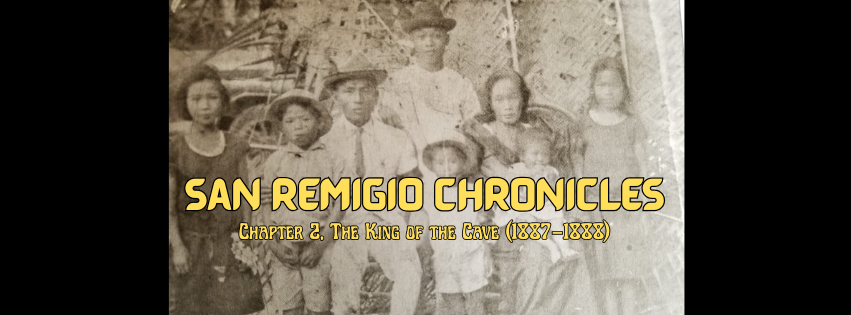San Remigio Chronicles: Chapter 2, The King of the Cave (1887–1888)
(Rewritten from the account of Deogracias M. Petinglay)
SAN REMIGIO
Rosalinda Velasco Petinglay
10/24/20253 min read


The relative peace that followed Don Rafael Baladjay’s return to San Remegio was shattered four decades later by a different kind of insurrection—one fueled by fervor and faith. In August 1887, an extraordinary rumor began to spread across the region, traveling from Hantik to Valderrama and Dao: a man named Hilario, known by the alias Gregorio Palmero, had established himself in the deep cave of the barrio of Igba-ong and had been crowned King.
This cave, suddenly transformed into an imaginary ‘palace,’ became a powerful focal point. People flocked to Igba-ong by the day, gathering to witness the King. They brought gifts, turning the pilgrimage into a steady stream of tribute. The newcomers were not simply curious; they became zealots, submitting themselves as subjects of the King, swept up by a fervor that promised hope and power outside the confines of colonial rule.
The reports of these mass gatherings eventually reached the ears of Don Castor Libertino, the Gobernadorcillo of San Remegio. He saw not a religious gathering, but a budding political threat—a potential revolt against the established order. Don Castor swiftly dispatched his local forces, known as the Sumatan, with orders to capture the ‘King’ and bring him back for trial.
Hilario was apprehended, and a formal denouncement was lodged before the Justice of the Peace, Don Cesario Murillo. Yet, the legal proceedings dissolved almost as quickly as they began. The judge, recognizing Hilario, knew him simply as a pastor of his own animals, and judged the whole affair to be the work of an insane man. The "King of the Cave" was released, the courts dismissing the political threat as mere madness.
The dismissal, however, only fueled the movement. After only a week’s stay elsewhere, Hilario returned to his imaginary palace in Igba-ong. His followers, now convinced their leader possessed some protective, even divine, favor since the authorities had not punished him, rallied to him in greater numbers than before. Submitting themselves fully to his orders, they formed an army led by Martin Tandayag.
The army marched from Igbaras, moving toward Monte Olay in the Municipality of Hantik. Their path was marked by their growing aggression: near the barrio of Pis-anan, they befriended the local inhabitants while summarily putting to death the assigned Guardia Civil. They continued their trek until they reached Mt. Olay, where they were finally intercepted and attacked by Spanish forces. The rebels fought fiercely, managing to repel and route the government troops.
The climax of the uprising occurred in May 1888. Hilario’s forces marched toward the capital of Antique province, but their intentions were miscarried. Seeing a large crowd exiting the church, they mistook the procession—held for the Feast of Corpus Christi—for government troops. The rebels launched an attack, initiating a chaotic battle that was fiercely defended by a Spaniard and his wife, local residents who were part of the procession. The fighting continued for long hours until detachments of the Guardia Civil arrived from Guintas, Sibalom, and San Jose to provide critical aid. The forces of Hilario were ultimately defeated and put to flight.
Yet, once again, a crucial detail emerged after the smoke cleared: Hilario himself was reportedly untouched, having suffered no injury in the fray. This apparent invulnerability drew even more people into his orbit.
Toward the end of that May, Hilario and his followers regrouped in Igba-ong in even greater numbers. After intensive preparations, they transferred their entire force to the locality of San Martin with the grim intention of finally attacking the provincial capital. This time, however, the government had better intelligence. A local worker named Dionisio Vilvar, knowledgeable about Hilario’s strength, offered his services to the Politico-Militar Governor of San Jose. He and Pedro Mandigal were immediately dispatched as guides for the Spanish forces.
On June 9, 1888, the troops arrived at Lumpatan, south of San Martin. They moved in two coordinated platoons: the first positioned on a hill to train its guns on the rebels, and the second, under Sgt. Felix Velasco, marched along the Maninila River to flank and capture the stronghold. The ambush was effective. The fight lasted only thirty minutes; the rebels, demoralized by the surprise and the overwhelming firepower, retreated, leaving their dead. Those who survived were captured and paid a terrible price, suffering the tortures of the Provincial Jail or deportation to the remote islands of Palawan, Puerto Princesa, and Mindanao. The messianic uprising was crushed, but the spirit of resistance, no matter how misguided, had again stained the soil of San Remegio with blood.
